
Problems regarding the Awase Tidal Flat area
- by The Save-Awase-Higata Association
- (Higata means tidal flats in Japanese)
- web site in Japanese: http://www.awase.net/
or contact us at: save_awasehigata@yahoo.co.jp
23rd October 2008
The Awase Landfill Project is to reclaim the expanding coastal wetland off the eastern coast in Okinawa City, covering 187ha. The red circle indicates the first phase of the landfill (96ha), and the blue circle indicates the second phase of the landfill (91ha).
The Okinawa General Bureau (the central government) and the Okinawa Prefectural government have been proceeding the first phase of the landfill plan. In the fiscal year 2007, the construction work of the revetment (seawall, bank protection) was completed. From 2009 it will be started to bring dredged soil (derived from another site for a harbor and a ship water cause) from a nearby municipality (The red arrow indicates the delivering route of dredged soil).
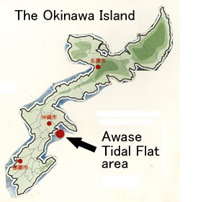 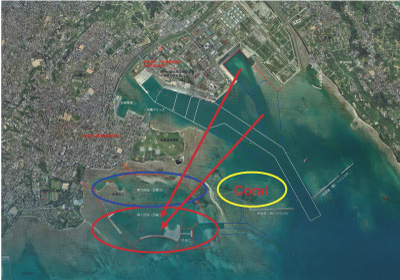
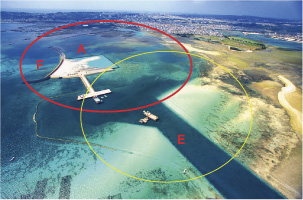 |
The red circle shows the landfill area. The yellow circle shows the habitat of newly found molluscan species Semelangulus lacrimadugongi, Leucotina sp.
'A' indicates the habitat of coral Acropora aspera; 'F' indicates coast protection for an artificial beach; and 'E' shows
the water cause for ships. |
|
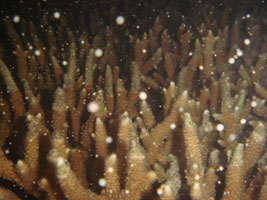 |
Large communities of Acropora aspera were found but not mentioned in the previous EIA document by the governments.
Coral spawning of Acropora aspera was first recorded on 8 June, 2007. This area is indicated with yellow circle. This place is going to be dredged in order to make a water cause for ships. |
|
This Landfill Project has been proceeded by the central and Okinawa Prefectural governments allegedly upon a request from Okinawa City. When the construction work is completed, the Okinawa Prefectural government is to purchase the land from the central government. Then Okinawa City will purchase the half of it, covering approximately 90ha, and build marine resort facilities (e.g., hotels, marina, artificial beaches). The purpose of this project is twofold.: one is to utilize this area as a disposal area for abandoning unnecessary dredged soil coming from the nearby construction site (the main purpose of the central government), and another one is to build marine resort facilities on this landfill area (the main purpose of the Prefectural government and Okinawa City).
Problems and issues:
- The two purposes of the plan are not critically urgent and without rationality.
- The Environmental Impact Assessment (EIA) was not performed thoroughly.
- Many new and ecologically valuable species have been found after the EIA
surveys and after the Landfill work was started. There are no plan to conserve
these species, and these important species are/will be buried alive. Nine
new species,121 of endangered fauna species (108 Mollusks, 7 Crustacea,
and 6 fish) and many endangered flora species have been recorded. As many
as 12 seagrass species have been found inhabiting this area, which makes
this area of the highest seagrass biodiversity in Japan.
- This is a typical example of unnecessary construction works in Japan. A
world-class and biodiversity-rich wetland, which meets criteria for the
listing under the Ramsar Convention, is now being lost.
- The plan has not been fully supported by local citizens (A majority of
people opposed this plan according to various polls).
- There have been requests to stop the plan and concerns have been expressed
nationally and internationally: e.g., Secretary General of the Ramsar Convention,
the Australian Minister of Environment, and the Japan Federation of Bar
Associations.
New species, ecologically important and endangered species found after the construction started.
 |
| Seagrass: Halophila okinawense J. Kuo, 2006 |
|
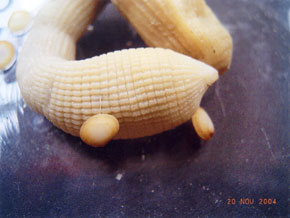 |
Mollusc: Leucotina sp. (Gastropoda. Undescribed species. Symbiosis with bivalve)
Solen soleneae Cosel, 2002 (Bivalvia)
Litigiella pacifica Lützen & Kosuge, 2006 (Bivalvia. Symbiosis with sipunculan worm. Type locality is Awase.)
|
|
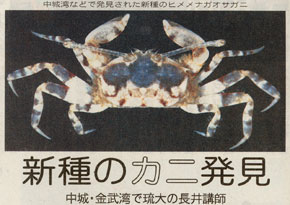 |
| Crab: Macrophthalmus (Macrophthalmus) microfylacas NAGAI, WATANABE & NARUSE, 2006 (Type locality is Awase.) |
|
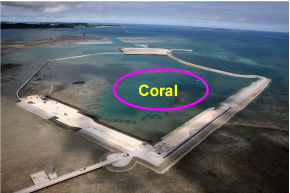 |
| First Phase of the Landfill. The construction work of the revetment (seawall, bank protection) has completed. |
|
|







